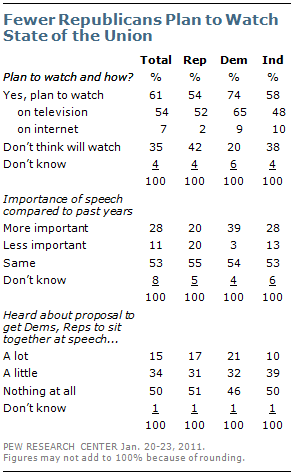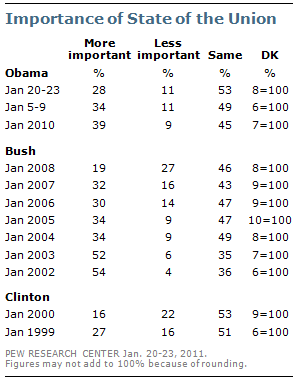Summary of Findings
 Most Americans say they plan to watch President Obama’s State of the Union address Tuesday night. Still, a sizable majority sees the speech to Congress as no more important than in previous years.
Most Americans say they plan to watch President Obama’s State of the Union address Tuesday night. Still, a sizable majority sees the speech to Congress as no more important than in previous years.
In the latest survey by the Pew Research Center for the People & the Press, conducted Jan. 20-23 among 1,001 adults, 61% say they plan to watch the State of the Union address, either on television (54%) or the internet (7%). About a third (35%) say they don’t think they will watch the State of the Union, Obama’s first since Republicans took control of the House in the 2010 elections.
In January 2007, shortly after Democrats took control of Congress, 59% said they planned to watch George W. Bush’s State of the Union speech, while 37% said they did not.
Nearly three-in-ten (28%) say this year’s speech is more important than addresses in past years, while 53% say it is about as important and 11% say it is less important. The number saying this speech is more important is down from just before Obama’s 2010 speech (39% more important).
The address also comes just weeks after the Jan. 8 shooting rampage in Tucson, Ariz., that nearly killed one House member, Democrat Gabrielle Giffords. Views about the importance of this year’s State of the Union are roughly similar today to what they were in a survey conducted largely before the shootings.
 Democrats are far more likely than independents or Republicans to say they will watch the president’s speech. Fully 74% of Democrats intend to watch it either on television (65%) or online (9%). That compares with 58% of independents and 54% of Republicans who say they will watch the speech either on TV or on the web.
Democrats are far more likely than independents or Republicans to say they will watch the president’s speech. Fully 74% of Democrats intend to watch it either on television (65%) or online (9%). That compares with 58% of independents and 54% of Republicans who say they will watch the speech either on TV or on the web.
Democrats also are more likely to view this year’s speech as more important than past State of the Union addresses: 39% of Democrats say this, compared with 28% of independents and 20% of Republicans.
By contrast, there is little partisan difference in awareness of proposals to have Republican and Democratic lawmakers sit together during the speech as a show of unity. Roughly half of Democrats (53%) say they have heard a lot (21%) or a little (32%) about this; comparable percentages of independents (49%) and Republicans (48%) say they heard at least a little about these proposals.
Bush’s Early Speeches Seen as More Important
The public’s perceived importance of the speech is not much different than during most years of George W. Bush’s presidency. Still, Americans saw the two Bush speeches following the Sept. 11, 2001 terror attacks as more important than usual; 54% said this in January 2002, while a similar number (52%) said this in January 2003 amid the buildup to the Iraq war and growing concerns about the economy.
From 2004 to 2007, roughly a third viewed Bush’s State of the Union as more important than previous years’ addresses. That percentage dropped to 19% in January 2008, shortly before Bush’s final State of the Union.
About the Survey
The analysis in this report is based on telephone interviews conducted January 20-23, 2011 among a national sample of 1,001 adults 18 years of age or older living in the continental United States (671 respondents were interviewed on a landline telephone, and 330 were interviewed on a cell phone, including 135 who had no landline telephone). The survey was conducted by interviewers at Princeton Data Source under the direction of Princeton Survey Research Associates International. A combination of landline and cell phone random digit dial samples were used; both samples were provided by Survey Sampling International. Interviews were conducted in English. Respondents in the landline sample were selected by randomly asking for the youngest adult male or female who is now at home. Interviews in the cell sample were conducted with the person who answered the phone, if that person was an adult 18 years of age or older. For detailed information about our survey methodology, see: https://legacy.pewresearch.org/politics/methodology/detailed.
The combined landline and cell phone sample are weighted using an iterative technique that matches gender, age, education, race, Hispanic origin, region, and population density to parameters from the March 2010 Census Bureau’s Current Population Survey. The sample also is weighted to match current patterns of telephone status and relative usage of landline and cell phones (for those with both), based on extrapolations from the 2010 National Health Interview Survey. The weighting procedure also accounts for the fact that respondents with both landline and cell phones have a greater probability of being included in the combined sample and adjusts for household size within the landline sample. Sampling errors and statistical tests of significance take into account the effect of weighting. The following table shows the sample sizes and the error attributable to sampling that would be expected at the 95% level of confidence for different groups in the survey:


Sample sizes and sampling errors for other subgroups are available upon request.
In addition to sampling error, one should bear in mind that question wording and practical difficulties in conducting surveys can introduce error or bias into the findings of opinion polls.


